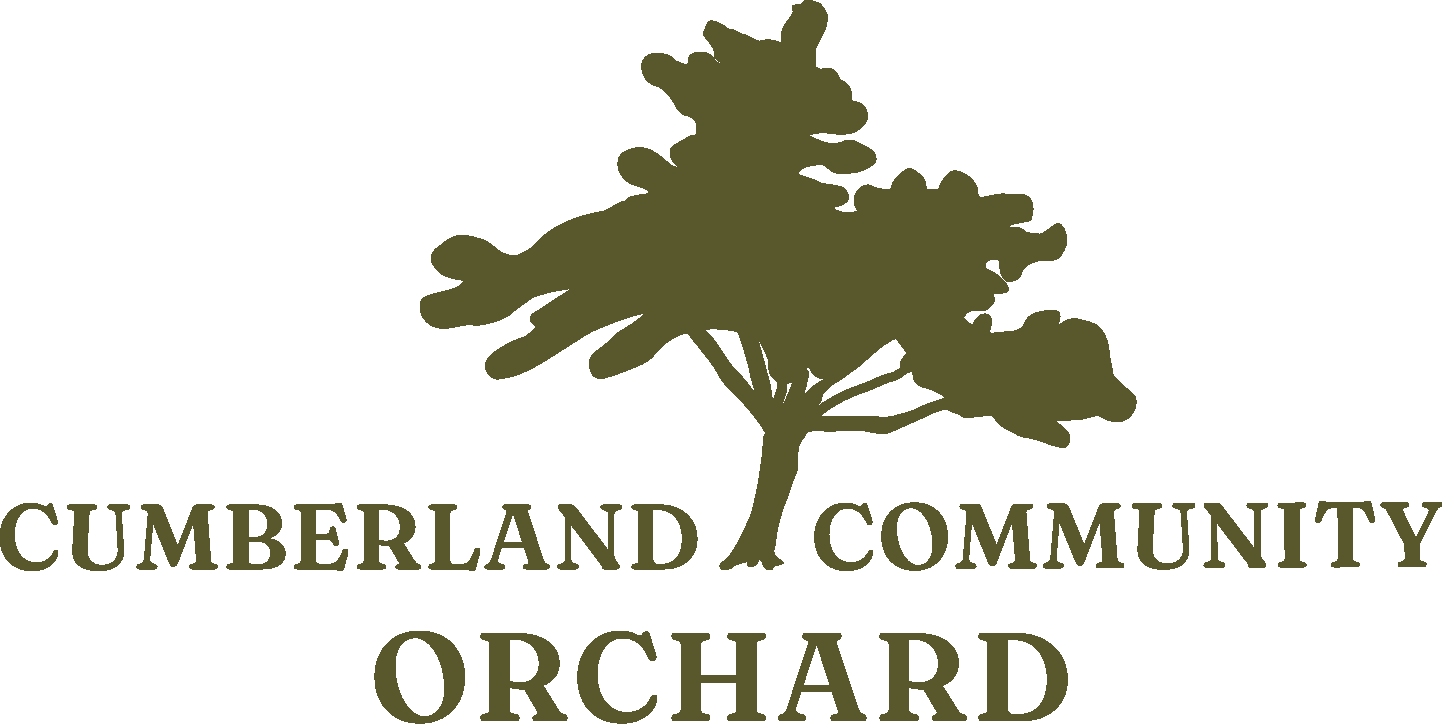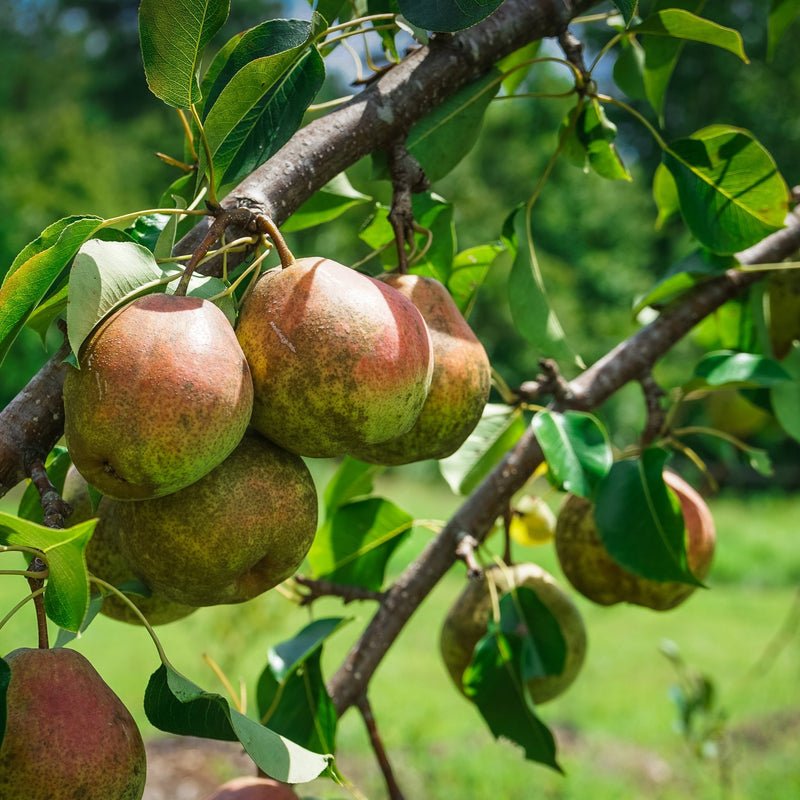Pears
Pears offer sweet, nutritious fruit perfect for fresh eating and culinary creations
June’s Pear
Pyrus communis Early Fall. Unknown parentage. Pownal, Maine.
Initially listed in the Fedco catalog as Beurre d’Amalis, recent DNA test results has shown this to be incorrect. In the past they have also offered this pear under the provisional name Pownal. The description remains the same and fully matches the fruit of the tree now offered as June’s Pear. No matter the name, this is a pear worth growing.
Very high-quality dessert and cooking pear introduced to us by June Lacombe and Bill Ginn of Hawk Ridge Farm in Pownal, ME, whose beautiful locally famous tree dominates their backyard. June wrote to us that the tree produces “an abundant crop of large sweet juicy fruit. It is thick skinned and must be eaten when it first ‘dents’ with your thumb while the skin is still green. At that point, it is tender, fragrant and luscious. We have collected pear recipes for years to use the prolific produce from this ancient tree and fattened our homegrown turkeys on the excess.” Z4/5.
Beurre Hardy
Pyrus communis Early Fall. Raised by M Bonnet, Boulogne-sur-Mer, France, c. 1820. Named to honor the director of the Luxembourg Gardens in 1830. Brought to the U.S. mid-century.
Introduced to Fedco by Mark Fulford of Teltane Farm. Large light yellow fruit veiled and dotted with russet. When perfectly ripe, the fruit is very soft, melting, dissolving, practically all juice. You can take a bite and droplets of juice appear on the fruit where you bit.
Perfumy and not overpoweringly sweet. No grit at all. Does not keep. Trees are vigorous, hardy, healthy and productive. Z4.
Buffum
Pyrus communis Fall. Possibly a seedling of White Doyenne. Rhode Island, early 19th c.
Small (about 2" long) heirloom dessert pear with deep brownish-yellow skin and a reddish blush. Flesh is white, rich, melting and aromatic. Ripens in late September to early October, around the same time as Seckel. For best flavor, pick fruits early and store them in a cold place (around 35°) for at least a week before bringing them to room temperature to fully ripen. The tree is vigorous and considered ornamental with its glossy foliage.
Fedco says theirs tend to shoot for the sky, so train it early to spread and stay low unless you have a very tall ladder. Somewhat resistant to fireblight. Bears biennially. Rare. Z4.
Cabot Vermont
Pyrus communis Fall. An old dessert pear, circa 1850, discovered in Cabot, Vermont, a few miles west of the New Hampshire border and about as far north as Bangor, Maine.
A superior dessert pear with medium-large oblong pear-shaped fruit. Yellowish skin has a slight reddish blush. Yellowish sweet flesh is coarse grained, extremely juicy, with no grit cells. Not only is it a delicious dessert fruit, it is also remarkable for its very rare “double” flowers. Highly ornamental! Introduced to us many years ago by Armando Bona of Passumpsic, Vermont. Not to be confused with the old Massachusetts pear named Cabot.
Annual and self-pollinating. Very hardy. Z4 or possibly even Z3.
Palmero
Pyrus communis Fall. Unknown origin. Sourced from an old tree standing tall in the front yard of the Palermo Historical Society. For years Fedco thought this was the old New York variety Columbia, but recent DNA profiling was not a match. May be a child of the Italian pear Professor Moron.
Good dessert pear, and excellent for canning and sauce. Large yellowish-green oblong fruit has yellowish-white granular sweet juicy flesh. Similar in appearance to Bartlett. Large vigorous spreading productive tree bears very heavily every other year. Year-round it’s a majestic sight, especially in fruit. People from all over stop by and put the fruit to good use. Z4.
Devoe
Pyrus communis Late Summer. Possibly a seedling of Clapp’s Favorite. Marlboro, NY, 1947.
Fine-grained buttery melting white flesh is juicy and sweet with notes of honey and vanilla. Very attractive large elongated pyriform fruit with a bright spotted reddish-pink blush—like a stretched out Bosc with the coloring of Clapp’s. The USDA’s pear germplasm repository describes it as “pretty enough to pose for a still life.” Best for fresh eating, does not keep well. Eat when it gets soft right around the stem. Z4.
Magness
Pyrus communis Late Summer. US 3866-E Giant Seckel (SP149490) x Doyenne du Comice USDA, 1960.
Rich, melting, buttery, juicy, sugary, tender, highly perfumed and aromatic with almost no grit cells. Renowned plant breeder Elwyn Meader rated Magness as the standard by which to judge other pears in taste and quality. Some call it the best-flavored pear ever.
Medium-sized fruit is greenish-yellow with a light dull-bronze russeting, sometimes a crimson blush, and a short pyriform—almost oval—shape. Fruit set can be inconsistent, though Fedco heard of one grower who got excellent fruit set by mashing up flowers from other pear varieties and spraying them on his Magness when it was in full bloom. Keeps more than two months with refrigeration.
Vigorous spreading tree. Will not pollinate other varieties. Some insect resistance and excellent fire blight resistance. Z4.
Rogue Red
Pyrus communis Fall-Winter. 5-235 [Comice x (Seckel x Farmingdale seedling #122)] Frank Reimer intro, Southern OR Exp Stn, Medford, OR, 1969.
Very sweet high-quality late-ripening dessert pear with buttery cream-colored flesh and very few grit cells. Large Seckel-shaped mostly red-blushed and partially russeted fruit. Harvest about the time of Bosc. Said to be a very good winter keeper. Sometimes mistakenly called Rouge Red, an understandable slip-up considering its red skin. Vigorous upright annual-bearing moderately productive tree. Shows tolerance to fireblight; resistant to pear scab. Z3/4.
Seckel
Pyrus communis Late Summer. Seedling found near Philadelphia, Pa., early 1800s. Sometimes called Sugar Pear.
Often considered the best-flavored of all pears; even the skin is delicious. Small squat fruit is russeted yellowish-brown often with deep red blush. Juicy, spicy, distinctive and aromatic. Eat ripe off the tree, or pick firm and ripen later. Fedco recommends using Seckels to make baked pear sauce. It’s wonderful.
Very productive annual-bearing large tree, easy to grow. The most reliably bearing pear tree we have in our home orchard. Scab and fireblight resistant. Z4.
Summercrisp
Pyrus communis Midsummer. MN N33201 (Gaspard No. 5) Brought to the MN Hort Res Stn by John Gaspard in 1933, likely discovered as a wild seedling. U Minn, 1986.
Large fat very sweet dessert and canning pear with green skin and a red blush. Ripens in August in Maine. Eat them fresh, can them in quarters, and juice the rest. Precocious annually bearing tree, medium-sized with typically conic habit. Considered the hardiest variety in the Minnesota collection. Free from fireblight. One of the most popular pears Fedco offers. Z3.










